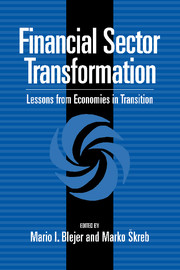Book contents
- Frontmatter
- Contents
- List of Contributors
- Introduction: Financial Reforms and Economic Transition: An Overview of the Major Issues
- PART I GENERAL STUDIES
- PART II COUNTRY STUDIES
- 5 Banking Crises in the Baltic States: Causes, Solutions, and Lessons
- 6 Monetary and Exchange Rate Policy, Capital Inflows, and the Structure of the Banking System in Croatia
- 7 Monetary and Financial Market Reform in Transition Economies: The Special Case of China
- 8 The Financial Sector and High Interest Rates: Lessons from Slovenia
- 9 Bank Rehabilitation in Slovenia: With Emphasis on Nova Ljubljanska Banka
- 10 Liberalization and Financial Reforms: Lessons from the Israeli Experience
- PART III AFTERWORD
- Index
7 - Monetary and Financial Market Reform in Transition Economies: The Special Case of China
Published online by Cambridge University Press: 05 November 2011
- Frontmatter
- Contents
- List of Contributors
- Introduction: Financial Reforms and Economic Transition: An Overview of the Major Issues
- PART I GENERAL STUDIES
- PART II COUNTRY STUDIES
- 5 Banking Crises in the Baltic States: Causes, Solutions, and Lessons
- 6 Monetary and Exchange Rate Policy, Capital Inflows, and the Structure of the Banking System in Croatia
- 7 Monetary and Financial Market Reform in Transition Economies: The Special Case of China
- 8 The Financial Sector and High Interest Rates: Lessons from Slovenia
- 9 Bank Rehabilitation in Slovenia: With Emphasis on Nova Ljubljanska Banka
- 10 Liberalization and Financial Reforms: Lessons from the Israeli Experience
- PART III AFTERWORD
- Index
Summary
Is China a “transition country”? The answer is no, if by transition country is meant one that is converting from the rule of a communist party to a democracy. The answer is yes, however, if what is meant is the transformation of an economy from monopoly state socialism toward decentralized entrepreneurial capitalism. If China has traveled a smaller distance down the road to political transition than its counterparts in Eurasia, it has in many respects made an even greater transformation on the economic front. If it is incorrect therefore to call China a transition country, it is undeniable that it is a transition economy.
China stands out as a special case among transition economies for several reasons. In the first place, not under the thumb of the Soviet Union, it was able to begin its economic transition more than a decade earlier than the Eurasian economies. A second difference is that it entered its economic transition as a primarily agricultural economy, starting from a much lower level of economic development than countries in Eurasia. A third difference lay in its transition strategy, which emphasized reform by sectors – sequential incrementalism – rather than gradualism or shock therapy. A fourth difference is that its growth strategy focused on the creation of free economic zones, the promotion of the international sector, and strong encouragement of foreign investment. A fifth difference is that it resisted the temptation to use the money-inflation tax as a source of finance and has instead made strong efforts through central bank policy and monetary reform to keep inflation under control.
- Type
- Chapter
- Information
- Financial Sector TransformationLessons from Economies in Transition, pp. 265 - 308Publisher: Cambridge University PressPrint publication year: 1999



